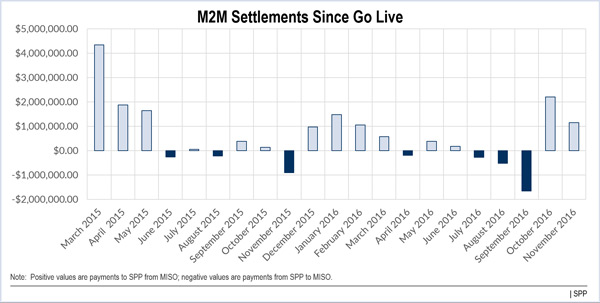SPP stakeholders agreed on Wednesday to amend a two-year-old policy paper and clarify when FERC approval would be needed to allocate costs for some seams projects between 100 kV and 300 kV.
The Seams Steering Committee voted 6-1 in favor of the change.
The change clarifies that the RTO will recover costs for seams projects greater than 300 kV under its regionwide highway cost allocation methodology. Costs for projects lower than 300 kV would also be allocated under highway funding unless the project meets certain criteria. In those cases, the Regional State Committee or Markets and Operations Policy Committee could recommend costs be allocated using SPP’s highway/byway methodology.
The highway/byway methodology considers facilities of 300 kV or above as highway facilities, with their costs allocated on a regionwide, postage stamp basis. Facilities between 100 kV and 300 kV are categorized as byway facilities, with two-thirds of the costs assigned to the host zone and one-third allocated regionwide. Projects below 100 kV are allocated entirely to the host zone.
Under the revised language, projects or tie lines of 100 kV or higher within a seams partner area could be allocated regionwide. Alternatively, based on the results of a seams project study, the RSC and the MOPC may recommend the Board of Directors approve cost allocation under the highway/byway cost allocation methodology, with the byway costs assigned to a zone expected to receive at least 60% of the project’s benefits. If the board approves such cost allocation, it would seek FERC approval on a project-by-project basis.
Within SPP, projects and tie lines of 100 kV or higher could also be allocated regionwide subject to FERC approval on a project-by-project basis, potentially expanding the number of projects that can be funded through the highway/byway methodology. FERC approval would be required only if the Tariff does not already allow such cost allocation.
Otherwise, based on the seams project study, the MOPC and/or the RSC can recommend the board approve highway/byway cost allocation if a single zone will receive at least 60% of the benefits. No FERC approval would be required.
SPP defines seams projects as non-interregional projects of 100 kV and above that benefit the RTO and one or more neighbors with a minimum cost of $5 million, and usually require a benefit-cost ratio of at least 1.0. SPP and the seams partner must agree to cost sharing.
ITC Holdings’ Marguerite Wagner cast the lone dissenting vote. Wagner and ITC contended the revisions would carve out seams projects from FERC’s Order 1000 process “without justification.”
Wagner expressed a preference for FERC-enforceable joint operating agreements to determine project cost allocation. David Kelley, SPP’s director of interregional relations, noted that would require the negotiation of a series of JOAs with multiple seams partners.
“I don’t know whether there’s a one-size-fits-all formula we can put down,” he said.
Two other committee members, the Northeast Texas Electric Cooperative and Xcel Energy, abstained.
The FERC filings would be necessary because the SPP Tariff does not currently allow highway/byway cost allocation of seams projects.
The policy changes reflect input from the board and RSC since the paper was originally approved in 2014. Staff said the paper will remain separate from SPP’s business practices and other governing documents and not require a revision request.
The revisions struck previous language that would have required seams projects greater than 300 kV to be recovered according to the highway/byway methodology. Those projects below the 300-kV threshold would have been recovered regionally through highway funding.
The committee will now send the policy paper to the Cost Allocation Working Group for its review. It hopes to have a finalized document for approval by the April meetings of the board, MOPC and RSC.
SPP-AECI Joint Study Recommends Two Projects
SPP and Associated Electric Cooperative Inc. staff are proposing two joint projects addressing thermal overloads and high-voltage issues along their seam in southern Missouri, according to a draft version of the biennial SPP-AECI Joint and Coordinated System Plan report released Friday.
The report identified a reactor in and/or around SPP’s 345-kV substation in the Brookline area and a new 345/161-kV transformer at AECI’s Morgan substation, along with an uprate of the 161-kV line between Brookline and Morgan, as being “mutually beneficial” to both entities.
Kelley told the committee the Morgan portion of the projects is “effectively” on the AECI system and will still have to undergo a regional review.
SPP and AECI evaluated 56 different potential transmission solutions to address the Brookline area’s needs. Staff looked at five targeted areas in all but determined one was no longer an issue and agreed the other three could be managed without joint projects.
Any final solutions will be coordinated with the SPP 2017 Integrated Transmission Planning’s 10-year assessment.
The joint study focused on predetermined target areas “to concentrate study resources on the geographic areas along the SPP-AECI seam most likely to benefit from mutually beneficial transmission projects.” Those areas were determined by historical analysis, operational experience, recent regional planning efforts and stakeholder feedback.
The SPP-AECI joint operating agreement requires a joint study be conducted every two years to ensure “reliable, efficient and effective operation[s]” along the seam.
Stakeholder comments on the report are due to SPP’s Adam Bell or AECI’s James Vermillion by Friday. That feedback will be incorporated in the final version of the joint study, which will be posted on SPP’s website.
Based in Springfield, Mo., AECI is owned by six regional generation and transmission cooperatives.
MISO M2M Payments Total $1.2M in November
Staff’s monthly market-to-market update once again showed a large flow of dollars from MISO to SPP, primarily attributed to temporary flowgates between the two RTOs. MISO sent $1.15 million to SPP in November, with $879,305 coming from temporary flowgates, and it has now compensated its seams neighbor more than $12.4 million for M2M since March 2015.
Temporary flowgates incurred 265 hours of binding M2M, with permanent flowgates accounting for 92 hours binding.
– Tom Kleckner




